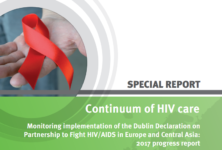The 66th session of the WHO Regional Committee for Europe was held in Copenhagen, Denmark on 12-15 September. Representatives from the 53 countries in the WHO European Region debated a set of action plans that affect public health. On September 14 Member States adopted Action plans for HIV and viral hepatitis.
European action plan for the health sector response to HIV
The new action plan on HIV/AIDS calls for an urgent and accelerated “treat all” approach to end the AIDS epidemic in the WHO European Region by 2030. Almost one million people are now on antiretroviral therapy and good progress has been made towards eliminating the mother-to-child transmission of HIV in Europe. The Region remains at a critical point with regard to HIV, however. While new infections are decreasing globally, new diagnoses have increased by 76% in the Region since 2005, more than doubling in countries in eastern Europe and central Asia. Only an estimated 21% of all people living with HIV were receiving treatment in 2015 in the eastern part of the European Region.
WHO/Europe developed the new Action plan for the health sector response to HIV in the WHO European Region through broad consultation in order to fast-track the response and halt the epidemic. Many delegates took the floor to detail their national activities and express their support for the Action plan. They focused on common themes, including the need to strengthen monitoring across countries; focus on high-risk groups; tackle stigma; ensure financial sustainability and involve civil society as well as high-risk groups themselves. Dr Nicolas Cantau of The Global Fund to Fight AIDS, Tuberculosis and Malaria reiterated a common concern regarding late diagnosis of HIV. Mr Michel Kazatchkine, United Nations Secretary-General’s Special Envoy for AIDS in Eastern Europe and Central Asia, as well as representatives of the Joint United Nations Programme on HIV/AIDS and several nongovernmental organizations all extended their support for the plan.
European action plan for the health sector response to viral hepatitis
An estimated 13 million people in the WHO European Region are living with chronic hepatitis B infection and about 15 million with chronic hepatitis C infection. Two thirds of those infected are in countries in eastern Europe and central Asia. Every day in the Region over 450 people still die of liver cirrhosis or cancer, although prevention tools and life-saving treatment are available.
The new Action plan for the health sector response to viral hepatitis for the WHO European Region is the first of its kind. It was adopted by Member States with wide consensus. Following on the adoption of a resolution at the World Health Assembly in May 2016 to intensify the global hepatitis response, this Action plan is considered a major step towards the goal of eliminating viral hepatitis from the WHO European Region by 2030.
Many countries shared their national initiatives and applauded the Action plan, noting that it provides a concrete road map for their efforts that can be adapted to local circumstances and resources. They emphasized the importance of hepatitis B vaccination as the most effective tool to prevent the disease, and advocated for combating hepatitis C through raising awareness and increasing access to effective and affordable medicines.
WHO/Europe underlined the need to share information transparently in order to work together more effectively and meet the global and regional goal of elimination.


 ПОИСК ПО САЙТУ
ПОИСК ПО САЙТУ  поиск по ресурсному центру
поиск по ресурсному центру 


